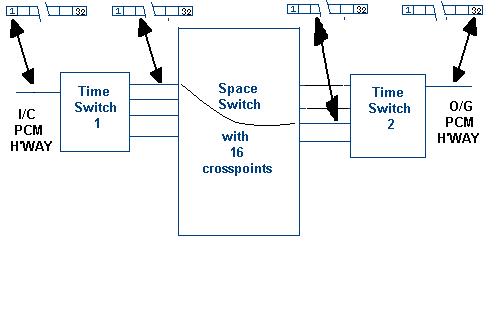
The Southern Railway telephone exchange at Madras is an OKINode 2000-line stored program control digital switch. It is manufactured in India under license by Crompton Greaves Ltd. The Node is based on a Time-Space-Time switching architecture, and the existence of a space stage implies that blocking is possible. But this blocking is under acceptable limits and manifests itself only during very high-usage periods combined with long hold times, which rarely happen.
The Stored Program Control feature of the switch means that the switch is actually controlled by a very fast computer running a stored program that has instructions telling it what it to do. The stored program control switch has an important advantage over the older electromechanical and electronic switches in that functions are implemented as routines in software code, and new functions are just a question of a newer software release.
The fact that the switch is digital implies that the incoming and outgoing channels that are switched are actually different PCM highways with time slots between the incoming and outgoing PCM links being interchanged. In fact, time slot interchange is a basic feature of a time switch. This switching of time slots in the PCM highways allows the switch to provide true non-blocking operation, but in practical cases, there is always some degree of blocking, which as mentioned before, is acceptable, and rarely ever occurs.

The figure above explains the concept of PCM switching better. Note that the time slots indicated are just for explanation, and in reality, the zero-th time slot of a 30 channel PCM is not used to carry voice traffic.
The OKI Node uses E/M signalling ( channel associated signalling ) on all trunks with other exchanges. This might be the only negative feature of the switch, because this makes the switch a non-ISDN switch. ISDN requires the switch to support Common Channel Signalling, specifically, CCITT No. 7 signalling, also called Signalling System No. 7 ( SS7 ). All newer exchanges in the Southern Railway are ISDN switches. In fact, there is also a Corel ISDN switch operating as a trunk automatic exchange that only connects trunks from other exchanges and has no direct subscribers. This switch is ISDN-ready because it is SS7-capable.
The OKI Node switch at Madras has subscribers throughout the Southern Railway HeadQuarters in Madras. It also serves remote subscribers as far as Villipuram, 150 km away from Madras. If there were more than 500 subscribers at a remote location, there could be a remote line unit installed, that would ensure the standard copper loop impedance and also make the use of trunks more efficient. But in the case of very few subscribers at a remote location, as the case is here, one channel in the transmission system to that location is used to handle the subscriber line. The exchange subscriber line terminates in a subscriber interface card at the PCM transmission multiplexer, and at the remote end, the subscriber's phone is connected to the counterpart exchange interface card. The subscriber is now transparently connected to the exchange at Madras.
The trunks between all the switches in the Southern Railway are the digital multiplexed transmission links that are described in another section. The transmission equipment handles all kinds of bi-directional end-to-end signalling between the switches which could be E/M signalling or common channel signalling, and uni-directional loop signalling between the remote subscribers and the switch.
manisridhar at hotmail dot com